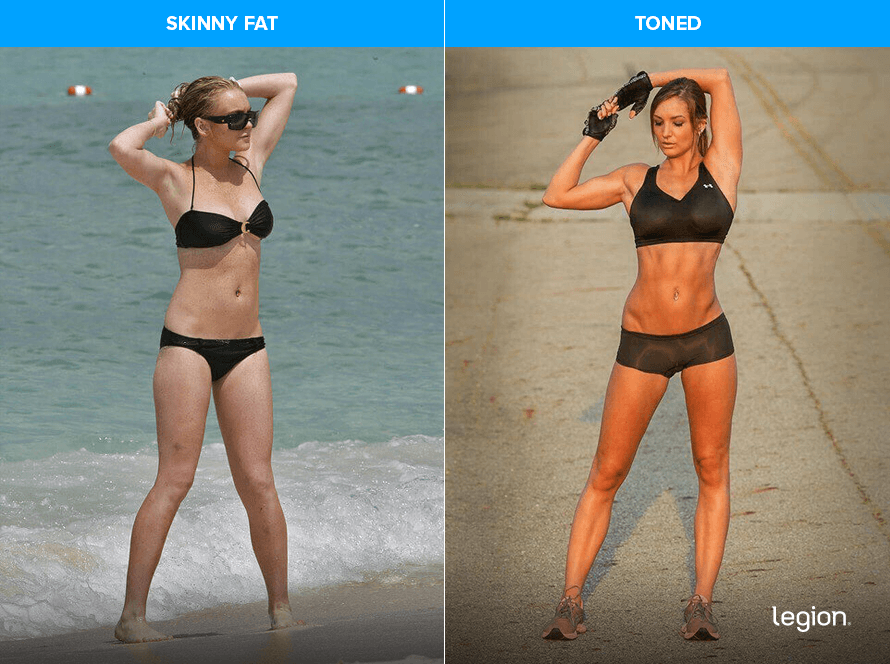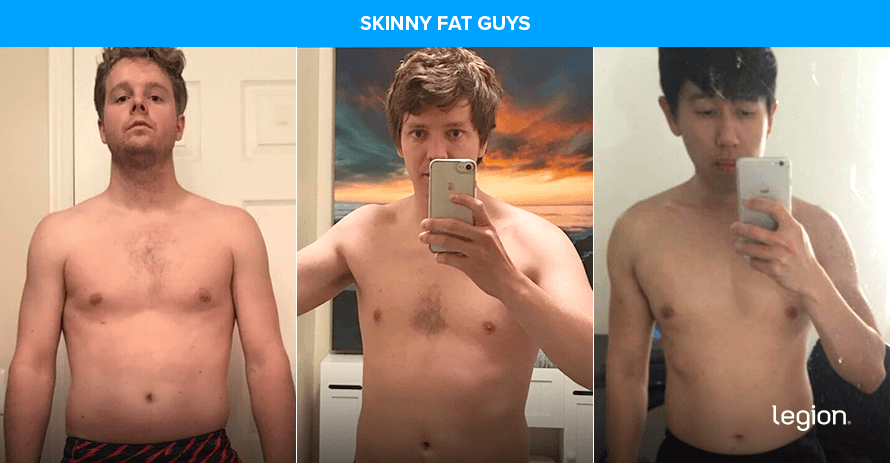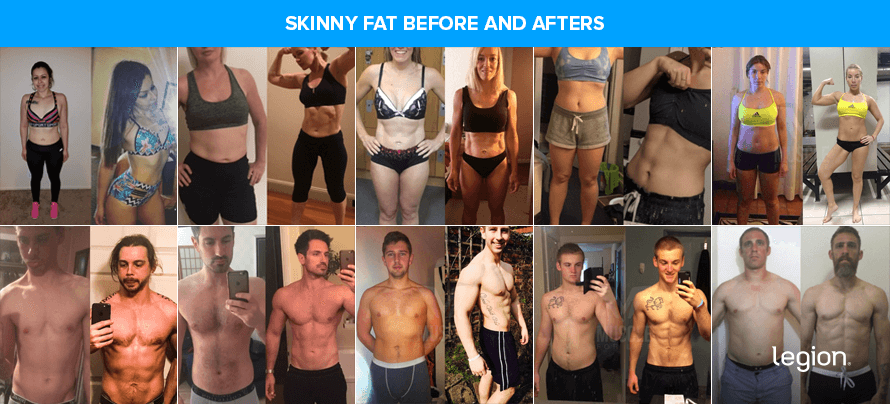Someone with a skinny fat body type has too little muscle mass and too much body fat.
They often look normal or even skinny when wearing clothes, but are soft and flabby underneath. In other words, they’re skinny and fat simultaneously.
Skinny fatness often afflicts people who think they’re doing everything right with their diet and workouts. Even if you go to the gym regularly, do cardio every week, and eat “clean,” you can still look skinny fat.
So, what causes skinny fatness and how can you get rid of it?
You become skinny fat by making a handful of simple diet and training mistakes. Namely, severely restricting your calories, undereating protein, doing little or no strength training, or doing excessive cardio.
Fortunately, learning how to get rid of skinny fat isn’t too tricky. In this article, you’ll discover everything you need to know about how to lose the skinny fat body type.
Table of Contents
What Causes Skinny Fat?
The four main causes of a skinny fat body type are:
- Doing little or no strength training
- Eating too little protein
- Severely restricting calories
- Doing excessive cardio
Even if you have a relatively healthy weight or body mass index (BMI), it’s possible to have a skinny fat physique if you also have little muscle.
While losing weight can be helpful for improving your physique, it’s not as important as optimizing your body composition. For example, check out these pictures:

These women have similar body fat percentages. Despite the woman on the right being slightly leaner, the difference in their physiques is the amount of muscle they have. The woman on the left has little and the one on the right has quite a bit.
This illustrates an important point: The less muscle you have, the more prone you are to looking skinny fat despite being at a healthy weight. An extremely under-muscled guy at 15% body fat can look skinny fat whereas a muscle-bound guy at the same level of body fat can look impressive.
Below are examples of both men and women with skinny fat physiques. As you can see, the people in these examples don’t look unhealthy, but they don’t really look “fit,” either.


How to Get Rid of Skinny Fat
In most cases, people with a skinny fat body type should prioritize building muscle first, as this will have the greatest impact on their appearance and health.
Then, once you’ve built some muscle, focus on losing your excess body fat, and you’ll start seeing drastic improvements in your physique.
That’s what these people did, and the results speak for themselves:

The one exception to this rule is if you’re new to proper weightlifting, in which case you can gain muscle and lose fat at the same time. Thus, beginner weightlifters should focus on losing fat first, as you’ll still be able to build a respectable amount of muscle while dieting.
Regardless of whether you cut or lean bulk first, here’s how to do it:
1. Focus on Strength Training
The main cause of skinny fatness is not having enough muscle. Since weight training is the most effective way to maintain and build muscle mass, it’s also the best way to lose skinny fat.
Heavy, compound weightlifting is your golden ticket to fixing skinny fatness. You can make every other mistake on this list, but if you also do lots of heavy weightlifting, you’ll still build muscle and be less skinny fat than previously.
You don’t have to do much to reap the benefits, either: 2-to-3 weightlifting workouts weekly is enough to see improvements, and 4-to-5 workouts weekly is optimal.
2. Eat More Protein
Eating too little protein deprives your body of the raw material it needs to build muscle, and thus makes it nearly impossible to gain muscle and strength. It also makes it harder to stay full after meals, increasing your chances of overeating and making fat loss more difficult.
As a rule of thumb, eat 0.8-to-1 gram of protein per pound of body weight per day, which works out to around 30-to-40% of your calories for most people.
3. Moderate Calorie Restriction
Severe calorie restriction can result in rapid muscle loss, especially when you aren’t lifting weights, which promotes skinny fatness.
This is why I recommend a moderate calorie deficit of about 20-to-25% when losing fat. Research shows that, when combined with a strength training program and a high-protein diet, this deficit allows for rapid fat loss while also preserving muscle.
4. Do Moderate Cardio
While doing cardio can help you stay healthy and lean, doing excessive cardio contributes to skinny fatness by interfering with your ability to gain strength and muscle. When combined with a very low-calorie, low-protein diet, lots of cardio can also speed up muscle loss even further.
Thus, you want to do a moderate amount of cardio to stay healthy and lean, but not so much that it interferes with your weightlifting workouts.
Is Having a Skinny Fat Body Type Unhealthy?
Being “skinny fat” doesn’t automatically mean you’re unhealthy, but you could likely improve your health and lower disease risk by losing fat and gaining muscle.
While many believe a “healthy” BMI indicates good health, it doesn’t account for body composition. You can have a healthy BMI but still carry an unhealthy amount of fat.
Research even suggests that it’s possible to be “metabolically obese” at a normal weight, which increases risks like insulin resistance, high cholesterol, and high blood pressure. This is especially true if you have a lot of visceral fat (fat around your internal organs, not to be confused with fat under your skin, called subcutaneous fat), which is associated with many diseases and an early death. And in many cases, these people are also skinny fat.
Not every skinny fat person will have these health problems, but keeping body fat in check is crucial for reducing disease risk. Equally important from a health and longevity perspective is building and maintaining muscle mass.
A study from the University of California showed that individuals with both high body fat and muscle mass had a lower risk of dying from heart disease compared to those with low body fat and muscle mass.
In other words, having more muscle (even with some fat) could be healthier than being skinny fat. Other studies also show that those with more muscle mass have a reduced risk of diabetes and cancer, and a higher overall quality of life.
FAQ #1: How can I tell if I’m skinny fat?
There isn’t a precise definition of what qualifies as a “skinny fat” body type.
Unless you’re a metabolically obese, normal-weight person, it’s primarily a subjective determination based on how you look.
That said, a good rule of thumb is if you’re a guy somewhere between 10% and 20% body fat or a woman between 20% and 30% body fat, you’re not naturally muscular, and you haven’t done any strength training in the past year or so (or ever), you’re probably skinny fat.
FAQ #2: How long does it take to go from skinny fat to fit?
This depends on how skinny fat you are and how quickly you lose fat and build muscle.
That said, most people can go from skinny fat to fit in about 3-to-6 months of diligently following a proper diet and training program.
FAQ #3: Should I do cardio if I have a skinny fat body type?
Many people use cardio as a scapegoat for skinny fatness, but this is wrongheaded. While cardio can exacerbate the mistakes that lead to skinny fatness, it rarely causes it on its own.
In fact, physical activity such as cardio can help you avoid becoming skinny fat if you follow the guidelines in this article and use it to improve your body composition synergistically with a proper diet and strength training program.
So, while you don’t have to do cardio if you’re skinny fat, it will help if you do it intelligently.
+ Scientific References
- Ballor, D L, et al. “Resistance Weight Training during Caloric Restriction Enhances Lean Body Weight Maintenance.” The American Journal of Clinical Nutrition, vol. 47, no. 1, 1 Jan. 1988, pp. 19–25, academic.oup.com/ajcn/article/47/1/19/4694815, https://doi.org/10.1093/ajcn/47.1.19.
- Helms, Eric R, et al. “Evidence-Based Recommendations for Natural Bodybuilding Contest Preparation: Nutrition and Supplementation.” Journal of the International Society of Sports Nutrition, vol. 11, no. 1, 12 May 2014, www.ncbi.nlm.nih.gov/pmc/articles/PMC4033492/, https://doi.org/10.1186/1550-2783-11-20.
- Soenen, Stijn, and Margriet S Westerterp-Plantenga. “Proteins and Satiety: Implications for Weight Management.” Current Opinion in Clinical Nutrition and Metabolic Care, vol. 11, no. 6, Nov. 2008, pp. 747–751, https://doi.org/10.1097/mco.0b013e328311a8c4.
- Durrant, M. L., et al. “Factors Influencing the Composition of the Weight Lost by Obese Patients on a Reducing Diet.” The British Journal of Nutrition, vol. 44, no. 3, 1 Nov. 1980, pp. 275–285, pubmed.ncbi.nlm.nih.gov/7437413/, https://doi.org/10.1079/bjn19800042.
- Huovinen, Heikki T., et al. “Body Composition and Power Performance Improved after Weight Reduction in Male Athletes without Hampering Hormonal Balance.” Journal of Strength and Conditioning Research, vol. 29, no. 1, Jan. 2015, pp. 29–36, https://doi.org/10.1519/jsc.0000000000000619.
- Ding, Cherlyn, et al. “Lean, but Not Healthy.” Current Opinion in Clinical Nutrition and Metabolic Care, vol. 19, no. 6, Nov. 2016, pp. 408–417, https://doi.org/10.1097/mco.0000000000000317.
- Sahakyan, Karine R., et al. “Normal-Weight Central Obesity: Implications for Total and Cardiovascular Mortality.” Annals of Internal Medicine, vol. 163, no. 11, 10 Nov. 2015, p. 827, annals.org/aim/article-abstract/2468805/normal-weight-central-obesity-implications-total-cardiovascular-mortality?resultClick=3, https://doi.org/10.7326/M14-2525.
- Srikanthan, Preethi, et al. “Relation of Muscle Mass and Fat Mass to Cardiovascular Disease Mortality.” American Journal of Cardiology, vol. 117, no. 8, 15 Apr. 2016, pp. 1355–1360, www.ajconline.org/article/S0002-9149(16)30155-2/fulltext, https://doi.org/10.1016/j.amjcard.2016.01.033.
- Haraldstad, Kristin, et al. “Changes in Health-Related Quality of Life in Elderly Men after 12 Weeks of Strength Training.” European Review of Aging and Physical Activity, vol. 14, no. 1, 30 May 2017, https://doi.org/10.1186/s11556-017-0177-3.
- Rizzoli, René, et al. “Quality of Life in Sarcopenia and Frailty.” Calcified Tissue International, vol. 93, no. 2, 5 July 2013, pp. 101–120, https://doi.org/10.1007/s00223-013-9758-y.
- Caan, Bette J., et al. “The Importance of Body Composition in Explaining the Overweight Paradox in Cancer—Counterpoint.” Cancer Research, vol. 78, no. 8, 15 Apr. 2018, pp. 1906–1912, cancerres.aacrjournals.org/content/78/8/1906.short, https://doi.org/10.1158/0008-5472.CAN-17-3287.
- Srikanthan, Preethi, and Arun S. Karlamangla. “Relative Muscle Mass Is Inversely Associated with Insulin Resistance and Prediabetes. Findings from the Third National Health and Nutrition Examination Survey.” The Journal of Clinical Endocrinology & Metabolism, vol. 96, no. 9, Sept. 2011, pp. 2898–2903, https://doi.org/10.1210/jc.2011-0435.









